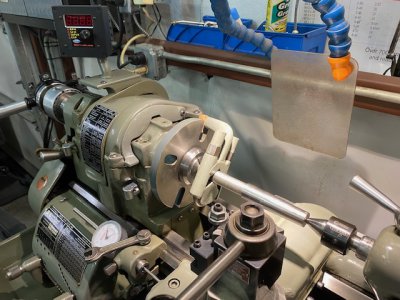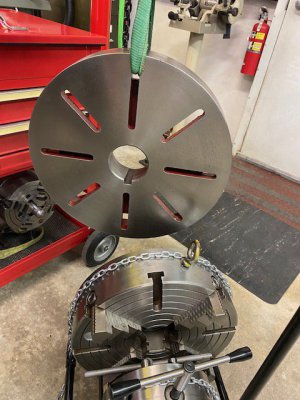When I got the lathe, 16" SB, the face plate and anything associated with it was missing. I would like to get all the parts together so I'd have the option. But dang, where in the world do you scrounge up parts for a 1962 SBL? Plus, looking at the parts diagram it looks like there is a bushing that goes in the spindle that holds the Morse #3, a thread protector (?) then the face plate...Am I correct?
I am a rookie when it comes to face plates...
Yes, for turning on centers you'll need a faceplate and a spindle adapter for 3mt. You do not need the thread protector--the faceplate will serve that duty (which isn't to protect the threads so much as to give you a way to drive the Morse taper adapter out of the spindle). The thread protector is used with the 5C collet closer, which fits into the spindle in lieu of the 3mt adapter when using collets.
(I still need to find the Morse-taper adapter for the spindle of my South Bend lathe, too, and for me it has also been unobtainium. But I have alternative strategies for turning on centers. One is a center with a 1/2" straight shank that I can mount in a 1/2" 4C collet. That collet closer will stand proud of my faceplate with plenty of clearance, and the faceplate itself will serve as the 4C collet adapter remover. That will probably be the most useful option. I also have a 1-1/2" straight to 2mt adapter that I can chuck up in the 4-jaw and indicate in, though it will stick out of the chuck too much for turning on centers. It will also mount in my weird shop-made collet chuck using a 1-1/2" collet, though without the ability to indicate it in and still too much stick-out. But I'll find a use for it.)
Look for faceplates with a "2-3/8 6tpi" in the search term on ebay. They come up more regularly than you think. There is one on ebay right now that is listed as 2-1/4 by 6, but it's really 2-3/8, and will fit the 16 and later 14-1/2" South Bends. (Earlier 14-1/2's like mine use 2-1/4 6tpi threads.)
The faceplate that people use for turning on centers is only 8" in diameter, and those threaded for South Bend threaded spindles are invariably made from cast iron. That's not big enough for a lot of potential turning operations, but it's fine for turning on centers. My lathe came with one (somewhat damaged but still usable) that is 7-1/2" in diameter. I finally found a big (11") faceplate with the 2-1/4 6tpi threads my 14-1/2 uses, but I searched for a while before it popped up and it wasn't cheap.
But if you can find an 7-8" faceplate, you can use it as an adapter for whatever fixture plate you can bolt to it. I've found a 12" steel fixture plate that is made from 1/2" plate that I intend to bolt to my 7-1/2" faceplate. It just needs threaded holes in the right spots to mount it, and more holes added as necessary for the various setups. The question will be whether it is true and flat, but I intend to bolt it to my smaller faceplate and then face it off in the lathe, which will true it up well enough for anything I do. I have no issue drilling holes in that plate for special fixtures, but I wouldn't want to drill random holes in a cast iron faceplate.
(Actually, I have several 12"-diameter fixture plates with open holes in the middle that could be mounted like that, but more is better.)
I don't own a mill, so I'll be using the fixture plate and the milling attachment to make stuff possible that wouldn't be otherwise.
As to its value for those who DO own a mill, it takes a pretty big mill to be able to mill flat a surface that is 10 or 12" in diameter. But that's not that difficult by using the toolpost as a trapanning tool for facing the surface of just about anything that can be bolted to the faceplate and spun without hurting people. The South Bends have the power and the slow speeds needed to get that job done on bigger stuff.
Rick "who would never use a crescent wrench as a hammer when there is a perfectly good pipe wrench available for hammering" Denney



